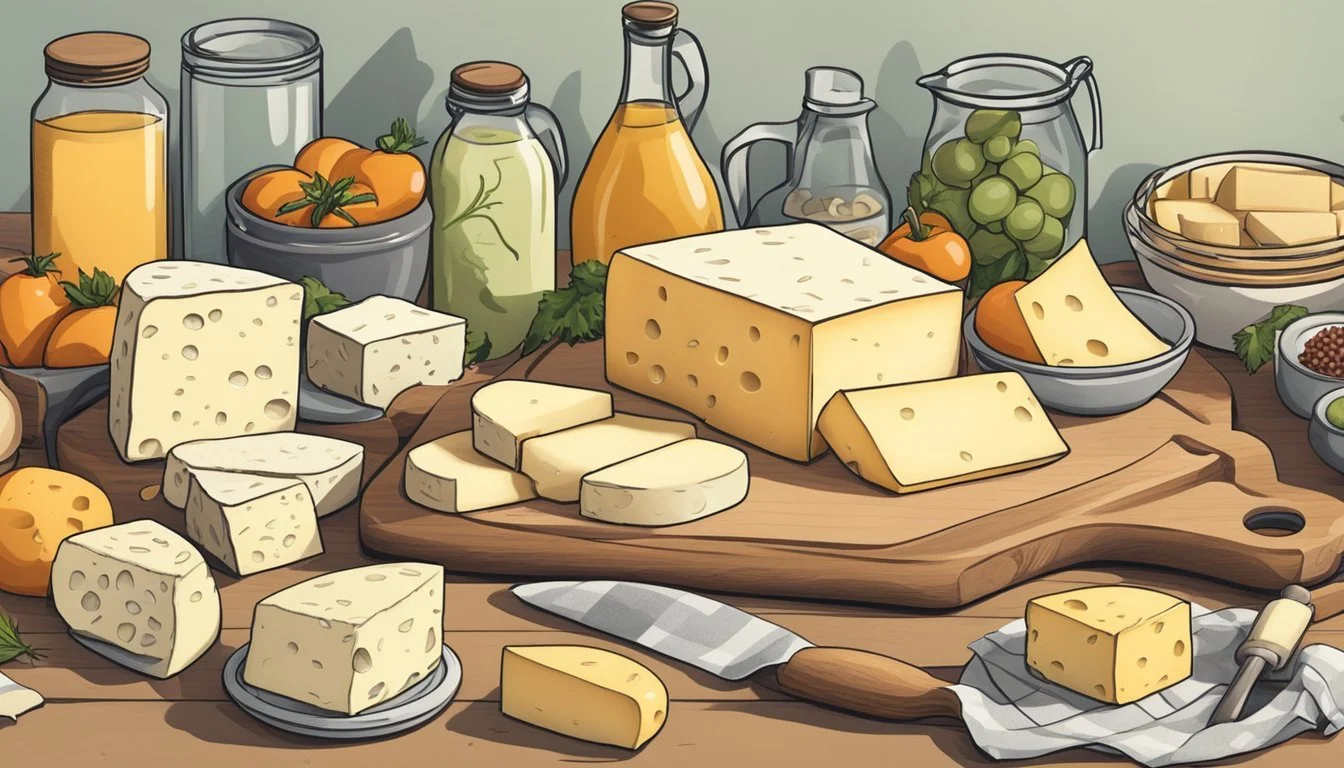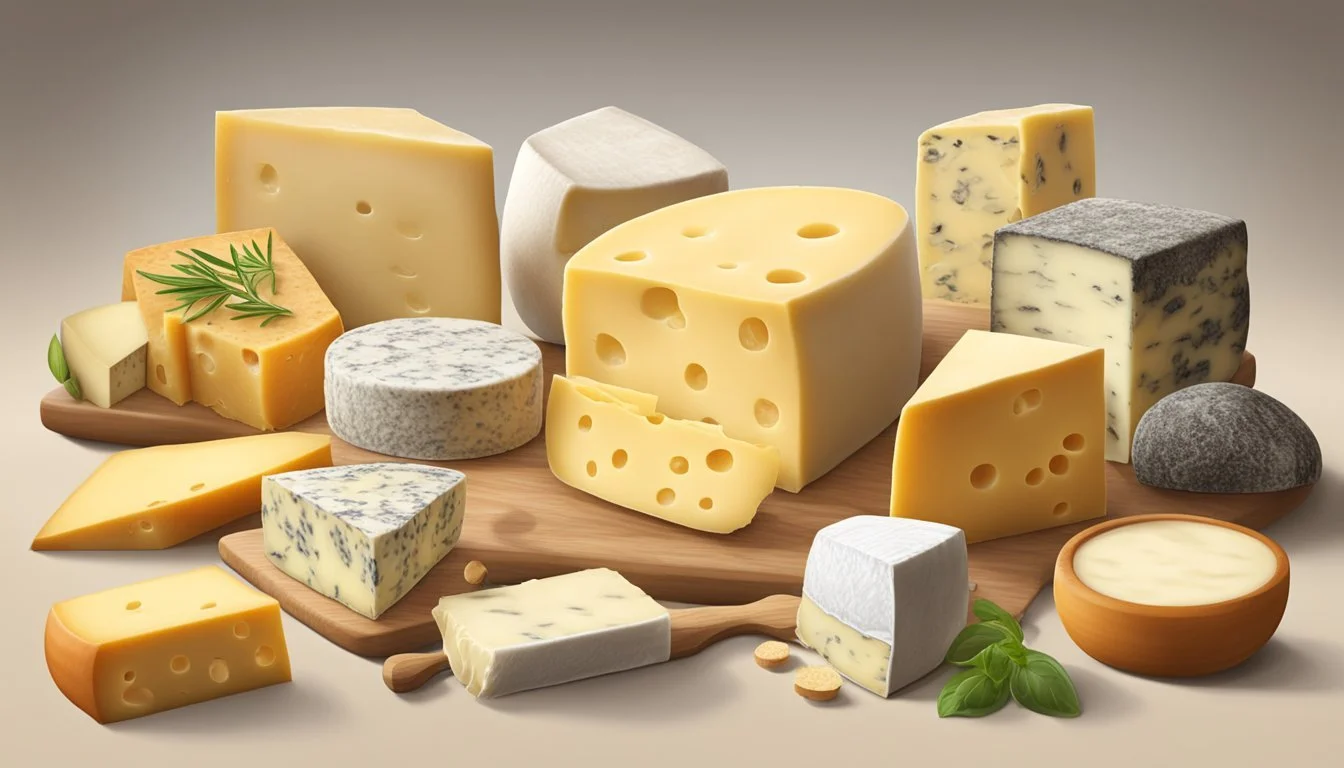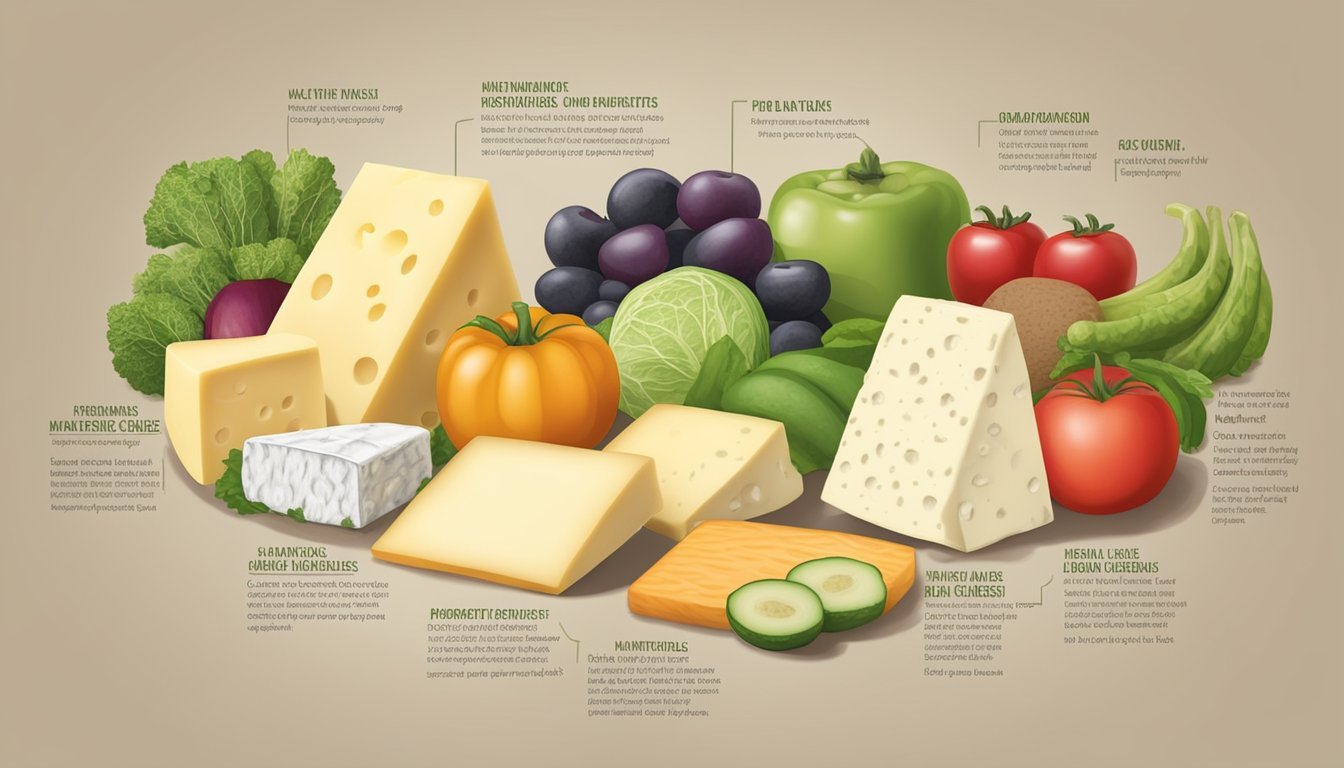Havarti Cheese Substitutes
Top Alternatives for Your Recipes
Havarti cheese (What wine goes well with cheese?) is a Danish delight known for its creamy texture and mild, buttery flavor. It's often used in cooking for its smooth melting properties, making it a favorite for sandwiches, pastas, and even as a table cheese. However, not everyone has access to Havarti or may seek alternatives due to dietary preferences or flavor profiles.
When selecting a Havarti cheese substitute, there are several options that closely mimic its characteristics. Gruyere is a suitable alternative with a slightly complex flavor, incorporating salty, earthy, and nutty notes. It shares Havarti's semi-soft texture, making it versatile in culinary applications. Tilsit cheese is another excellent substitute, offering a similar semi-hard texture and a flavor profile that closely resembles that of Havarti. It can be used interchangeably in recipes requiring a cheese that delivers on both taste and meltability.
Other suitable Havarti cheese substitutes include cheeses like Gouda, Edam, Monterey Jack, and Colby. These varieties offer mild flavors and melting qualities that work well in dishes where Havarti is called for. Each substitute brings its own unique touch to the palate, ensuring that the essence of the dish remains intact while providing a slight twist on the classic Havarti experience.
Understanding Havarti Cheese
Havarti, a traditional Danish cheese, is recognized for its creamy texture and mild flavor. It stands out with a unique blend of butteriness and versatility in culinary applications.
Characteristics of Havarti Cheese
Havarti is a semi-soft cheese celebrated for its creamy texture and buttery aroma. It typically has small openings or "eyes" throughout its interior. With a mild flavor that can range from near sweetness to slightly sharp, it is adaptable in various dishes.
Culinary Uses
Havarti's superb melting properties make it ideal for fondue, casseroles, and burgers. Its mild flavor works well in sandwiches and atop pizza. Additionally, it is a favorite on cheese boards and can enhance dishes like mac and cheese.
History and Origin
Originating from Denmark in the 19th century, Havarti cheese was first made by Hanne Nielsen. The name derives from her family’s farm, Havarthigaard, located north of Copenhagen.
Production Process
The process of making Havarti involves traditional cheese-making techniques. It starts with cow's milk, which is then pasteurized and curdled. The curds are pressed into cheese molds and aged to develop the flavor and texture.
Common Varieties
There are different varieties of Havarti, including Cream Havarti, which contains more milk fat for a richer taste. Another variation is Danish Tilsiter, a cheese related to Havarti but with a more pronounced flavor.
Nutritional Profile
Havarti cheese provides a good source of calcium and protein. The typical nutritional content for 1 ounce (28 grams) of Havarti cheese is as follows:
Calories: 120
Protein: 6 g
Fat: 10 g
Carbohydrates: 0.7 g
Calcium: 200 mg
In conclusion, Havarti cheese's distinct qualities contribute to its standing as a staple in Danish cuisine and international cheese platters.
Choosing Havarti Substitutes
When selecting a substitute for Havarti cheese, it's essential to consider factors such as flavor, texture, and how the cheese behaves when melted. This ensures that the replacement closely mimics the characteristics of Havarti cheese in your dish.
Deciding Factors
Choosing an appropriate Havarti substitute depends on several key characteristics:
Flavor: Look for cheeses with a buttery, creamy, and sometimes nutty flavor similar to Havarti.
Texture: Aim for a cheese that is semi-soft to semi-hard, which will provide the right mouthfeel.
Melting Properties: Opt for cheese that melts smoothly, making it suitable for various hot dishes.
Best Substitute Options
The following cheeses are among the best substitutes for Havarti:
Gouda: Offers a similar texture and a slightly sweet, nutty flavor.
Tilsit: Known for its creamy and somewhat fruity taste.
Edam: Mild in taste with a slightly firmer texture but melts well.
Fontina: Provides a creamy melt and a gentle, slightly nutty flavor.
Monterey Jack: Recognized for its mild taste and excellent melting quality.
Substitutes Based on Usage
For specific culinary applications, consider these recommendations:
Sauces and Soups: Gruyere, with its earthy, nutty taste and good melting quality.
Burgers and Pizza: Cheddar or Colby for their superb meltability and bold flavor.
Hot Dishes: Swiss cheese is an option for casseroles due to its melting capabilities.
Grating Over Dishes: Parmesan may be used for its hard texture and rich flavor.
Cheese Pairing Recommendations
When pairing these substitutes with other foods or beverages, these combinations work well:
Beer: A semi-soft cheese like Gouda complements the maltiness.
Fruits: Pair mild cheeses like Edam with pears or apples.
Vegetables: A nutty, mild cheese enhances the flavors of green beans or zucchini.
Red Wine: Hard cheeses like aged Gouda or a firm Fontina can stand up to the robustness of the wine.
Cheese Texture and Taste Substitute Guide
Consider the following as a quick reference for texture and taste:
Buttery and Creamy: Look towards Fontina or young Gouda.
Nutty Flavor: Aged Gouda or Tilsit are top picks.
Mild Taste: Edam or Monterey Jack fit the bill.
Shopping Tips for Substitutes
When shopping for Havarti substitutes, keep in mind:
Availability: Choose cheeses that are readily available in the grocery store.
Versatility: Opt for a cheese that can be used across a variety of recipes.
Appearance: Select a cheese that looks similar if the dish is to be presented in a particular way.
Alternative Cheeses in Cooking
When looking for Havarti cheese substitutes in culinary applications, it is important to select cheeses that offer similar melting characteristics and a complementary flavor profile to ensure the integrity of the dish.
Substitutes in Hot Dishes
Gruyere: For casseroles, lasagna, and sauces that require a cheese with good melting capabilities, Gruyere stands out with its complex, nutty flavor. It adds a caramelized buttery zest when used in hot dishes and can hold itself well in fondue.
Tilsit: This semi-hard cheese is an excellent Havarti alternative in macaroni dishes and soups due to its close texture and ability to melt smoothly. It also balances acidity in tomato-based pastas, providing a rich and creamy feel.
Substitutes in Cold Dishes
Jarlsberg: Often featured on cheese boards, Jarlsberg's mild, nutty flavor makes it suitable for cold sandwiches and salads, accommodating for the less pronounced Havarti. Its versatility is also seen in its use in cold pasta dishes.
Monterey Jack: The cheese's creamy texture and mild flavor profile allow it to integrate well in cold culinary preparations. It excels in being a complementary component rather than overpowering the dish.
Creative Uses for Cheese Substitutes
Cheeses used in place of Havarti can inspire creativity. For instance, melting cheeses can be used to add depth to homemade pizza toppings or to create gourmet grilled cheese sandwiches. They can also enrich stuffed mushrooms or peppers.
Preparing Cheeses for Maximum Flavor
Preparation can influence a cheese's impact on a dish. Grated or thinly sliced cheeses melt more effectively, essential for creating smooth cheese sauces or ensuring even coverage in lasagna layers. Letting these cheeses come to room temperature before integrating them can enhance their flavor.
Preserving and Storing Substitutes
Proper storage extends cheese shelf life and preserves quality. Cheese should be wrapped in parchment or wax paper, then stored in an airtight container. Most cheese substitutes for Havarti, like Gruyere and Monterey Jack, are best kept refrigerated, with the precise temperature contingent on their specific care instructions.
Exploring Global Cheese Varieties
When seeking out alternatives to Havarti cheese, a variety of global cheeses offer a similar taste and texture. These cheeses come from regions with rich cheese-making traditions and can be used in various culinary applications.
European Cheese Substitutes
Esrom: Originating in Denmark, Esrom, also known as Danish Port Salut, is a semi-soft cheese with a pungent aroma and a buttery, mildly spicy flavor.
Tilsit Cheese: Also called Tilsiter or Danish Tilsiter, this semi-hard cheese hails from Germany and Denmark, known for its strong smell and slightly fruity taste.
Saint Paulin Cheese: A French derivative of Dutch Edam, Saint Paulin offers a mild and creamy texture, making it a suitable Havarti substitute.
Comté Cheese: From the Jura region of France, Comté is a firm cheese with a nutty and complex flavor profile, suitable for those seeking a more mature taste.
Gruyère Cheese: A traditional hard Swiss cheese, Gruyère is renowned for its rich and slightly sweet flavor, often used in baking and melting applications.
American Cheese Substitutes
Monterey Jack Cheese: This semi-soft cheese, with its mild flavor and good melting qualities, makes it a practical substitute for Havarti in American cuisine.
Colby Cheese: With a milder flavor and firmer texture than Havarti, Colby is a cheese suitable for sandwiches and cheese platters.
Cheddar Cheese: Young cheddar is a feasible replacement with its smooth consistency and mild taste, making it a versatile ingredient in various dishes.
Unique Regional Cheeses and Their Uses
Butterkäse Cheese: A German cheese variety, Butterkäse (literally 'butter cheese') is known for its butter-like texture and delicately creamy flavor, excellent for melting over dishes that require a subtle cheesy touch.
Young Gouda: From the Netherlands, this cheese is semi-soft with a creamy and mild flavor. It's ideal for someone looking for a cheese that is easy to slice and melt but with a character different from Havarti.
Cheese-Making Regions and Their Specialties
Denmark: Apart from the creamy havarti, Denmark is known for producing Danish Tilsiter and Esrom, which carry unique flavors ideal for those who enjoy European cheeses.
Netherlands: Known for Edam and Gouda, the Netherlands offers a range of flavors from mild to mature, suitable for any cheese enthusiast's palette.
Germany: Renowned for varieties like Tilsit and Butterkäse, German cheeses contribute significant diversity to the cheese substitute spectrum.
France: This cheese-making giant produces Saint Paulin and Comté, each with distinct textures and flavors, showcasing France's broad cheese-making expertise.
Nutrition and Health Considerations
When considering Havarti cheese substitutes, one should examine their nutritional profile to align with dietary needs and health goals. Different cheeses can vary in lactose, fat, and protein content, as well as their potential to trigger sensitivities.
Lactose Content and Alternatives
Havarti, like many cheeses, contains lactose, an issue for those with lactose intolerance. Lactose-free cheese is recommended for these individuals. Substitutes like aged cheddar or lactose-free variants provide similar textures without the discomfort associated with lactose.
Fat and Calorie Content
For those monitoring fat and calorie intake, low-fat cheeses serve as suitable alternatives. Options such as part-skim mozzarella have less saturated fat and fewer calories compared to traditional Havarti, supporting a healthier eating pattern.
Protein and Calcium Levels
Havarti is a good source of protein and calcium, which are important for bone health. Alternatives like Gruyere and Edam are comparable, ensuring adequate intake of these nutrients. Balancing these levels is key for a balanced diet.
Incorporating Cheeses into a Balanced Diet
Diversifying cheese consumption can enhance diet diversification and provide a range of nutritional benefits. Incorporating a variety of cheeses, from creamy to firm, fosters healthy eating habits and supports a varied nutritional profile within one's diet.
Allergens and Sensitivities
Cheese allergies and sensitivities, especially to dairy, must be acknowledged. For those affected, dairy-free cheeses made from nuts or soy can be explored. Always check labeling for allergy information to ensure safe consumption.






